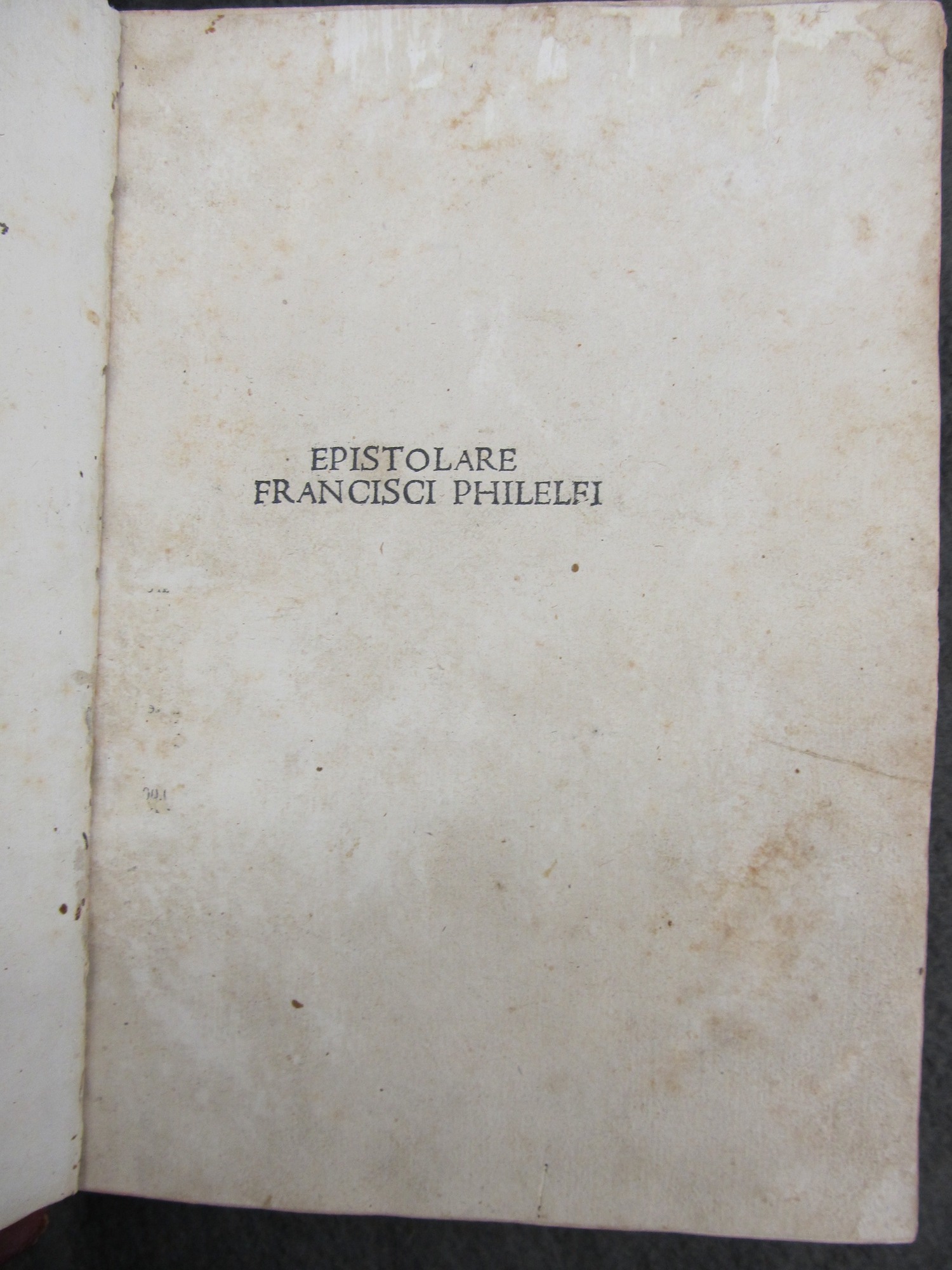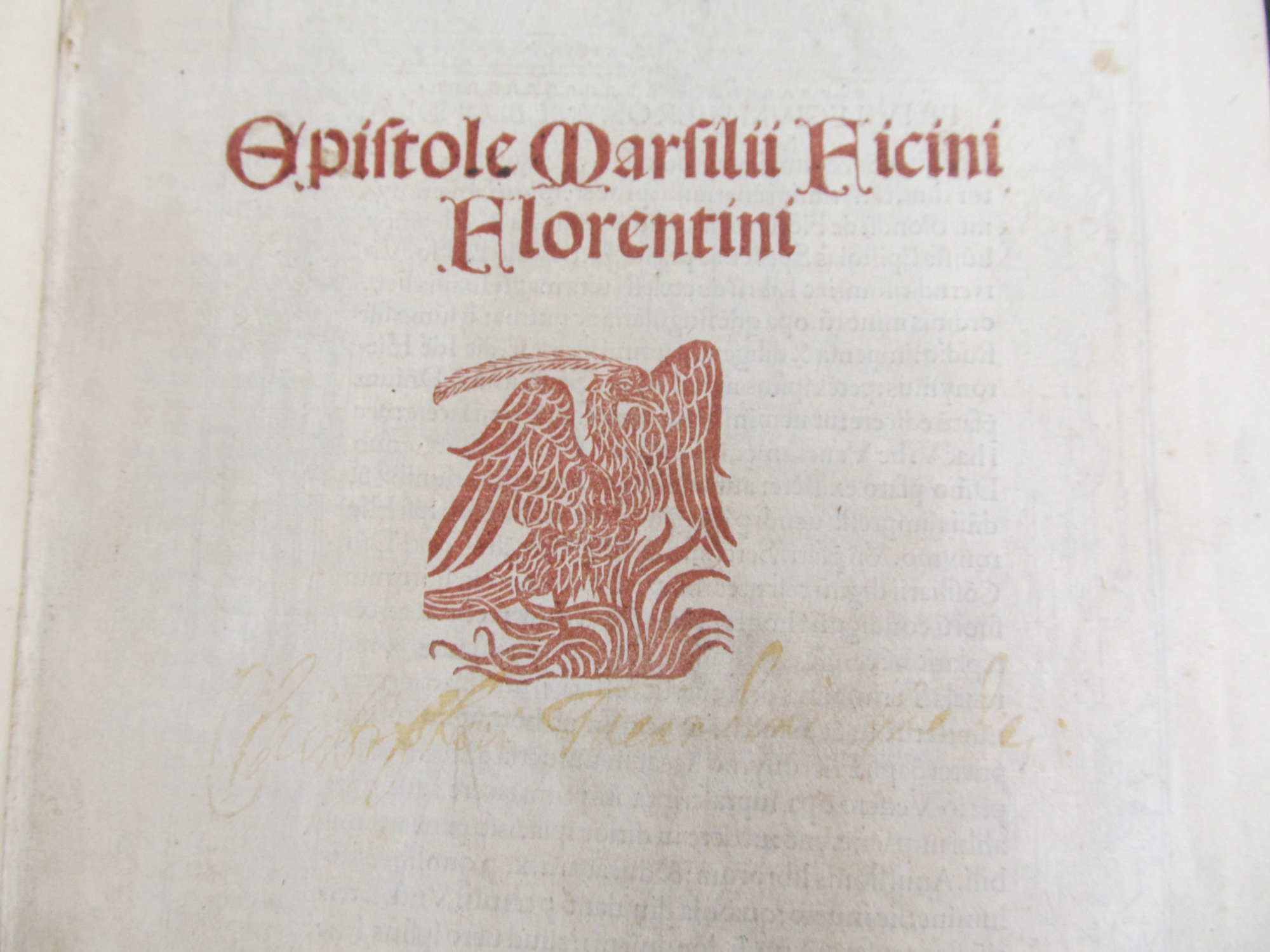Incunables in Special Collections
Humanist Letters
Today we may think of letters as inherently private affairs, but this was not the case for much of history. Most letter-writing was done in collaboration with a professional secretary and letters sometimes circulated in manuscript within elite social circles. Letter writing was seen as an important aspect of a proper education and different classical authors were used to model different types of letters, tapping into the general humanist method of imitating classical rhetoric. Collections of letters were also sometimes published, both to preserve correspondence and to demonstrate the erudition and social connections of the author. Such collections might or might not have been written to actual people: publishing a collection of letters was an excellent way to shape people’s perceptions of an author and their career.
Special Collections holds incunable collections of letters written by Francesco Filelfo, Marsilio Ficino, and Pope Pius II. Several of these collections were published either during their authors’ lifetimes or within a few years of their deaths: people were interested in reading the letters of the intellectual elites’ letters (and, potentially, in using them as a model for their own writing). These letters often include discussions of philosophy, geography, and local culture.
Humanist authors were often part of pan-European networks of correspondents. Their letters reflect a sense of being part of a community of thinkers whom they might never physically meet but with whom they shared similar concerns. In this regard, medieval and early modern correspondence has a passing resemblance to the Internet of today, which also facilitates discussions between like-minded individuals. Do you see any other parallels between these letter collections and communication today?
Epistolae
Filelfo, Francesco, 1398-1481
Venice: Joannes Rubeus Vercellensis, 28 Jan 1488
PA8520.F5 E6
The Italian humanist Francesco Filelfo was an important translator of Greek works into Latin, especially Aristotle, Plutarch, Xenophon, and Lysias. He moved around between different cities over the course of his career, eventually dying in Florence, but was highly respected everywhere. He wrote a 12,800-line epic, the Sforziad, to curry favor with his patron Francesco Sforza of Milan. As a side-note, he may have been a third cousin of Leonardo da Vinci.
This copy of Filelfo's letters has a fragile binding that offers a glimpse of the sewing work done to put the book together: the book's spine was lined with a piece of an older manuscript written in a Gothic script. Within the text itself, it has a manicule on the first page as well as regular (if not frequent) marginalia. It was printed by Joannes Rubeus, a printer from the northern Italian city of Vercelli who operated in Treviso as well as eventually settling in Venice.
Epistolae
Filelfo, Francesco, 1398-1481
Basel: Johann Amerbach, ca. 1496
PA8520.F5 E6 1496
This edition of Filelfo's letters was printed eight years after the other one held by Special Collections, indicating that the humanist's letters still had some staying power. It was printed by Johann Amerbach, a Basel-based printer who had studied under Johann Heynlin, a German-born professor at the Sorbonne who had helped establish the first printing press in France in 1470. Amerbach is noted for his scholarship and careful editing of the texts he printed. The Liber de scriptoribus ecclesiasticis held by Special Collections was also likely printed by Amerbach.
This copy of Filelfo's letters in our collection has numerous ownership marks: two book stamps, two bookplates, and further ownership inscriptions. Thanks to the ownership marks, two of the previous owners can be readily identified. Sir John Henry Thorold, 12th Baronet (1842-1922), served as a member of Parliament before becoming High Sheriff of Lincolnshire. Edwin Beresford (1868-1937) was an English author and historian who specialized in the history and topographical aspects of London. At the same time that it yields such provenance details, the book also shows signs of the old collectors' habit of attempting to destroy provenance: it was once washed to remove its annotations, though traces of them survive in the margins.
Epistolae
Ficino, Marsilio, 1433-1499
Venice: for Hieronymus Blondus Florentinus, 11 March 1495
B785.F43 E6 1494
Marsilio Ficino was a prominent Florentine philosopher, theologian, and linguist. He was a prolific translator of Greek into Latin, producing the first complete translation of Plato into any European language, and was heavily responsible for the revival of Platonism in Europe. Strangely for such an important thinker, none of Ficino's own works attained canonical status in their own right, though his translations remained in use until the 1700s. He carried on regular correspondences with many of the leading philosophers of his day.
Some editions of this book, including the one held by Special Collections, feature the title page and emblem in red rather than black. Rather than manual rubrication, the printer chose to use woodcut initials, a development that would eventually supplant rubrication entirely. While the book does not feature much annotation, researchers who are delighted by manicules should take a look at leaf K3, where two of them are on display.
Epistolae familiares
Pius II, Pope, 1405-1464
Nuremberg: Anton Koberger, 17 May 1496
BX1308 .A3 1496
Born Enea Silvio Piccolomini in 1405, Pius II's reign as pope is characterized by a drive towards church reform, particularly in terms of encouraging strict observance of the rules of life within religious orders, and an unsuccessful attempt to organize a crusade against the Turks, who had conquered Constantinople in 1453. Throughout his life, Pius II was a voluminous author, writing on general history, geography, and poetry. Pius II also wrote an erotic epistolary novel in Latin, Historia de duobus amantibus, albeit well before becoming pope.
Pius II collected his letters for publication himself. They contain one of the best known descriptions of the enthronement ceremony of the Carinthian dukes (a duchy located in southern Austria and northern Slovenia). This copy has a strikingly pictorial bookplate from the library of Louis Bosch, a curate in the Flemish town of Tamise: it features an elaborate depiction of a library interior with the inspirational Latin motto, "In tali numquam lassat venatio sylva." (Translated into English, the motto means "A hunt in such a forest never wearies.")
This edition of Pius II's letters was published by Anton Koberger, the prolific Nuremberg printer who also printed the Nuremberg Chronicle held by Special Collections.



